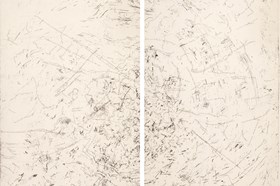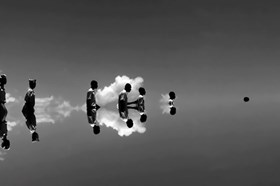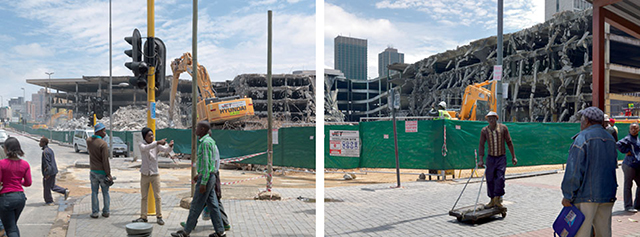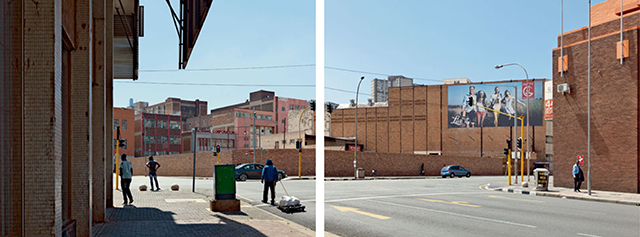gauteng reviews
The Formality of Joburg’s Other Side
Guy Tillim at STEVENSON in Johannesburg
By Michael Smith22 May - 27 June. 0 Comment(s)
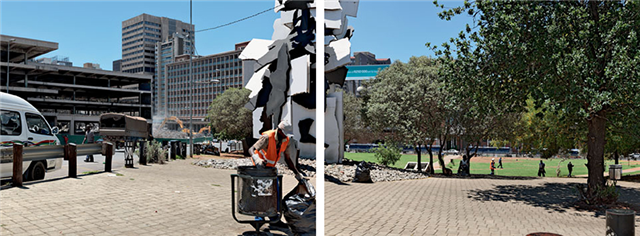
Guy Tillim
Simmonds Street,
2013.
Pigment ink on cotton paper
108 x 144cm each.
Living in Johannesburg, if you believe many of its white residents, is like living next door to the apocalypse. The city centre, we frequently tell one another, is beset by armies of homeless people lining pavements like the undead after the disappearance of the sun; that its town-planning dysfunction would make a Brazilian favela feel better about not being so left-brained; and that hijacked building slums abound, breeding the next generation of car hijackers. If we were given to poetry, we products of privilege would surely intone ‘the end is nigh’ over our lamb chops and lager, as the suburban sun set behind our Jeep-shirted shoulders.
art events calendar
VIEW FULL CALENDARbuy art prints
edition of 60: R11,000.00
About Editions for ArtThrob
Outstanding prints by top South African artists. Your chance to purchase SA art at affordable prices.
FIND OUT MORE Editions for artthrobThis hysteria is not without grounding. The misery of life on Jozi’s mean streets is apparent every night as far north as the gallery strip on Jan Smuts in Parkwood. While the Rea Vaya rebuild of Empire Road between Wits and Hillbrow – with its dramatic bottleneck of traffic racing off the M1 South – has to rank as one of the strangest decisions of urban planning on record. And the hijacks, both car and building, may have slowed down, but they haven’t stopped.
In 2004, Guy Tillim produced a body of work that now forms the other bookend to his recent show at Stevenson in Johannesburg. ‘Jo’burg’ (we still used the apostrophe back then) made much of the radical urban degeneration of inner city living spaces. Eviction by the Red Ants, Auret Street, Jeppestown (2005) was, arguably, the most powerful image of that series. The unforgettable scene of a pair of hands emerging from a doorway casually holding onto a pump action shotgun, while an evicted resident hauled a grimy mattress down the passageway, became for me emblematic of how far things had slipped. The city centre, from Hillbrow in the north, down into Joubert Park, and east over towards Bertrams and Observatory, was a plague of hijacked buildings into which slumlords were pouring thousands of exploited renters, desperate to get off the streets.
Warzone-like conditions of contested space necessitated that firearms be wielded in residential spaces. And then there were the bare concrete blocks of Eviction’s passage walls, the mainstay of cheap and illegal subdivision of the city’s formerly chic flats and apartments. In this one image, Tillim captured not only the awful claustrophobia and rancid conditions of an emerging class of black urbanites in Johannesburg; the image, too, suggested that the continuum between this body of work and many of Tillim’s others (‘Leopold and Mobutu’ from the same year; the child troops of 2003’s tragic ‘Soldiers’; and the forlorn refugees of ‘Kunhinga Portraits’, also from 2003) was solid, despite his shift to the urbanity of Africa’s most developed city.
A decade later, Tillim’s new body of work revisits Johannesburg’s inner city, and finds something altogether different. Maybe this time in ‘Joburg: Points of View’ he has exercised greater selectivity – for one thing, all of these images happen outside on the streets. Certainly he’s not seeking out broken windows or coils of belligerent razor wire. The homeless, the choking traffic and scores of indigent trying to eke out a living as car guards, security guards, hawkers and porters, often appear in shadows and the images’ peripheries, but they aren’t front-and-centre (except in Simmonds Street, in which a municipal worker changes a bin liner directly in front of William Kentridge and Gerhard Marx’s public sculpture Fire Walker). Instead, fairly well-dressed pedestrians make their way amongst redevelopments and demolitions (as in a second work also titled Simmonds Street; and in Tudhope Street); it’s not Paris in springtime, but it’s a darn sight better than the end of the world.
The body of work undoubtedly raises some reservations about this strain of Tillim’s methodology. Is it enough to present a seemingly exhaustive overview of the city centre without including said homeless? Or without the squalor and confusion of Joubert Park and the surrounding taxi rank? Isn’t it an act of wilful denial to ignore the disrepair of public buildings like the Johannesburg Art Gallery? This sense of a missed opportunity isn’t helped much by Tillim’s evasive press release, which seems keen to make a virtue of making no statement at all, saying that the project:
set… me off on a journey to make landscapes that would attempt, as far as possible, to be without pointed judgment, on the grounds that my judgment or preconceptions of a landscape, of a mountain or a skyscraper, say, are irrelevant in the face of its immutability. The process of finding an answer would call for making pictures that are more like windows than mirrors or pale reflections. A window's neutrality and its equitability would suggest intangible context; where the frame is no longer a tyranny, where it is an invitation to explore rather than state a claim. The frame cannot escape the question about what it can't see and can't know, but perhaps there's a place where the question simply ceases to arise.
As I read this in the gallery space, listening to the city seething outside, I thought to myself, ‘Pull the other one, Guy’. Now more than ever, questions around the politics of space and time, about what has been improved and what rots away in neglect, need to be raised. The statement’s lapse into formalist language, and the temptation just to ‘explore’ seem evidence of a curious impulse to return to a hands-off ethos of simple observation, without the hard-won understandings of postmodernism (here my mind wanders to Chris Wool’s The harder you look, the harder you look: seeing without discerning is anodyne).
And yet, despite these misgivings, it is really hard to quell the sense that Tillim is engaged in a debunking process; that the desperation of Johannesburg’s inner city is not as pervasive as many believe, or want to believe. Of course, the subtext of most fireside chatter about Johannesburg’s implosion is that black power is failing, that no one can run Johannesburg like the (white) Nats did. And while Tillim’s instinct for even-handedness thankfully prevents the whole from descending into post-liberation rainbowism, or the ‘nation-building’ about which the more misguided elements within the ANC government are so enthusiastic (the buildings in Quartz Street, Bruce Street and Carr Street aren’t derelict, but they could do with a fairly robust cleaning up), a balancing snapshot of life in the continent’s most important economic hub seems like a very significant political statement at this moment.


